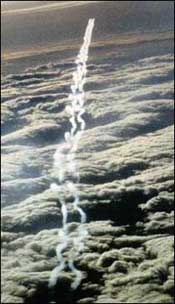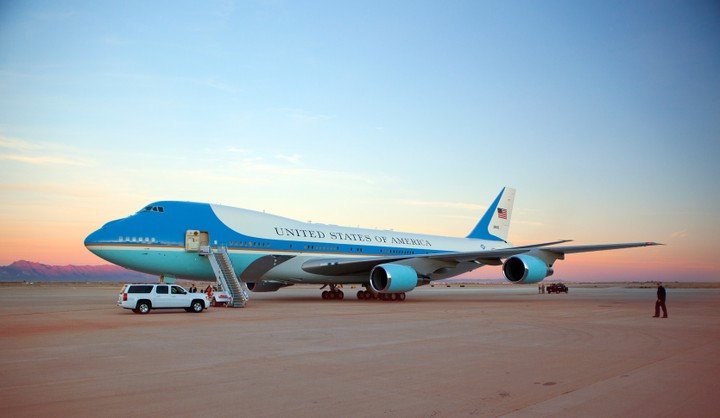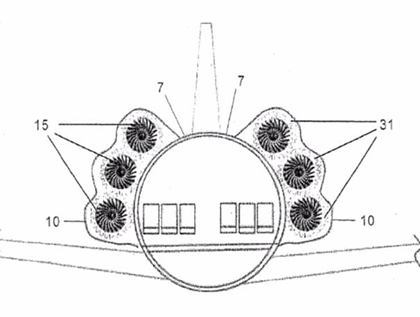| Aviation World by Nobody: 12:25am On Dec 18, 2015 |
8 things you might not know about black boxes
Often one of the first pieces of techno-speak that springs to mind when we hear of an aviation disaster - and a catch-all phrase popular with the media - is ‘Black Box,’ but how much do you really know about these vital pieces of equipment? Here are some things you might not know about black boxes
Here are some things you might not know about black boxes
1. They're not black
Black boxes are the same colour as the Golden Gate Bridge in San Francisco. They are a tone of what's known as international orange, which is a set of three colours used in aerospace and engineering to distinguish objects from their surroundings. The Golden Gate Bridge is a darker shade, while the international orange used for black boxes is much brighter.
2. A 'black box' comes in two parts
The "black box" is made up of two separate pieces of equipment: the flight data recorder (FDR) and a cockpit voice recorder (CVR). They are compulsory on any commercial flight or corporate jet, and are usually kept in the tail of an aircraft, where they are more likely to survive a crash. FDRs record things like airspeed, altitude, vertical acceleration and fuel flow. Early versions used wire string to encode the data; these days they use solid-state memory boards. Solid-state recorders in large aircraft can track more than 700 parameters.
3. They were invented by an Australian
Dr David Warren's own father was killed in a Bass Strait plane crash in 1934, when David was just nine years old. In the early 1950s, Dr Warren had an idea for a unit that could record flight data and cockpit conversations, to help analysts piece together the events that led to an accident. He wrote a memo for the Aeronautical Research Centre in Melbourne called "A Device for Assisting Investigation into Aircraft Accidents", and in 1956 produced a prototype flight recorder called the "ARL Flight Memory Unit". His invention did not get much attention until five years later, and the units were eventually manufactured in the UK and US. However, Australia was the first country to make the technology compulsory.
4. Experts don't call them "black boxes"
The term "black box" is favoured by the media, but most people in the know don't call them that. There are several theories for the original of the name "black box", ranging from early designs being perfectly dark inside, to a journalist's description of a "wonderful black box", to charring that happens in post-accident fires.
5. Only 2 hours of cockpit conversations are kept
Digital recorders have enough storage for 25 hours of flight data but only two hours of cockpit voice recording, which is recorded over itself in a loop. The CVRs track the crew's interactions with each other and air traffic control, but also background noise that can give vital clues to investigators. Earlier magnetic tape versions could only record 30 minutes of cockpit conversations and noise, which was also recorded in a loop.
6. It can take a long time to find one
Black boxes are fitted with an underwater locator beacon that starts emitting a pulse if its sensor touches water. They work to a depth of just over four kilometres, and can "ping" once a second for 30 days before the battery runs out.
7. They're virtually indestructible
FDRs are usually double-wrapped in titanium or stainless steel, and must be able to withstand atrocious conditions. The crucial part that contains the memory boards, the CSMU, is shot out of an air cannon to create an impact of 3,400 Gs and then smashed against a target. It is subjected to a 227kg weight with a pin attached to it, which is dropped onto the unit from a height of three metres. Researchers try to crush it, destroy it in an hour of 1,100 degree Celsius fire, submerge it in a pressurised salt water tank, and immerse it in jet fuel.
8. They're not as powerful as your phone
Passengers are able to text, stream and surf the internet but the data recorders on board are not communicating in real time with the rest of the world. However, the bandwidth needed to stream huge amounts of data from large aircraft is not currently feasible.
Source: Australia Trendolizer |
| Re: Aviation World by Nobody: 12:45am On Dec 18, 2015 |
Feel free to drop a comment
#flyHigh |
| Re: Aviation World by Nobody: 12:26am On Dec 20, 2015 |
So today I want to discuss about something that puzzles so many people...we see it occasionally but I can bet only few aviation enthusiast know the principle behind it occurrence...
Why do aircraft or rocket engine leave a white trail in the sky?
AKA CONTRAILS
The condensation trail emitted by jet aircraft or rocket exhaust are called contrails. Contrails form when hot humid air from jet exhaust mixes with environmental air of low vapor pressure and low temperature. The mixing is a result of turbulence generated by the engine exhaust. Cloud formation by a mixing process is similar to the cloud you see when you exhale and "see your breath" during winter or Harmattan Season in tropic regions... 
|
| Re: Aviation World by Nobody: 5:28pm On Apr 18, 2016 |
Air Force One – The Most Secure Aircraft in The World
Air Force One is the official air traffic control call sign of a United States Air Force aircraft carrying the President of the United States. In common parlance the term refers to those Air Force aircraft specifically designed, built, and used for the purpose of transporting the president. The presidential aircraft is a prominent symbol of the American presidency and its power.
The idea of designating specific military aircraft to transport the President arose in 1943, when officials of the United States Army Air Forces, the predecessor to the U.S. Air Force, became concerned with relying on commercial airlines to transport the president. A C-87 Liberator Express was reconfigured for use as a presidential transport; however, it was rejected by the Secret Service amid concerns over the aircraft’s safety record. A C-54 Skymaster was then converted for presidential use; this aircraft, dubbed the Sacred Cow, transported President Franklin D. Roosevelt to the Yalta Conference in February 1945, and was subsequently used for another two years by President Harry S. Truman.
Most people have a general idea that the president’s plane is a flying office with all sorts of high-tech equipment. But there are two essential facts about Air Force One that the general public isn’t aware of.
“Air Force One” isn’t technically a plane:
It’s simply the radio call name for any U.S. Air Force plane carrying the president of the United States. As soon as the president steps aboard an Air Force plane, that plane is referred to as Air Force One by the crew and all air traffic controllers, in order to avoid confusion with any other planes in the area.
If the president rides on an Army aircraft, that aircraft is Army One, and whenever he boards his specialized helicopter, that craft is Marine One. Civilians generally refer to the physical plane itself as Air Force One, of course, and we will in this article too.
Today, there are actually two planes that regularly fly under this designation – nearly identical Boeing 747-200B jets. The planes themselves are designated VC-25A, with tail numbers 28000 and 29000.
A number of aircraft types have been used as Air Force One since the creation of the presidential fleet, starting with two Lockheed Constellations in the late 1950s: Columbine II and Columbine III. It also has included two Boeing 707s introduced in the 1960s and 1970s, respectively; since 1990, the presidential fleet has consisted of two Boeing VC-25As.
The two planes have the same general structure as a normal Boeing 747-200B, and similar capabilities. They are almost as tall as a six story building, and they’re as long as a city block.
Each has four General Electric CF6-80C2B1 jet engines, which provide 56,700 pounds of thrust a piece.
The top speed is between 630 and 700 miles per hour and the ceiling maximum (how high the plane can fly) is 45,100 feet.
Each plane carries 53,611 gallons of fuel and weighs 833,000 pounds fully loaded for a long-range mission. With a full tank, the plane can fly half way around the world.
Air Force One has 4,000 square feet of interior floor space. Much of it looks more like a hotel or executive office than a jetliner, except for the seatbelts on all the chairs. The lowest level of the plane mostly serves as cargo space. Most of the passenger room is on the middle level, and the upper level is largely dedicated to communications equipment.
The president has onboard living quarters, with his own bedroom, bathroom, workout room and office space. Most of the furniture on the plane was hand-crafted by master carpenters.
Air Force One has a certain mythic, mysterious quality, largely because it is completely off limits to most of us. Even visiting politicians and journalists aren’t allowed in some parts of the plane, and the Air Force is careful to conceal specific details of the craft’s layout. A number of official and unofficial sources have published general descriptions of what’s inside the plane, but nobody (as far as we know) has said for sure how these pieces fit together. And if they did, they’d probably get a polite request to stop it for reasons of national security.
Here’s what we know: Like an ordinary Boeing 747, Air Force One has three decks. And, as you can see on TV footage of Air Force One, passengers can enter through three doors. Normally, when you see the president in the news getting on and off Air Force One with a wave, he is using the door onto the middle deck and a rolling staircase has been pulled up to the plane. Journalists normally enter through the rear door, where they immediately climb a staircase to the middle deck. Most of the press area looks something like the first class section of an ordinary jetliner, with comfortable, spaced-out seats.
The crew prepares meals in two fully-equipped galleys. They store a large amount of food in freezers in the lower sections of the plane. The crew is equipped to feed about 100 people at a time, and the storage area holds as many as 2,000 meals.
The plane has a lot of technology in its onboard medical facility. The medical room has an extensive pharmacy, loads of emergency room equipment and even a fold-out operating table. The plane also has a staff doctor, who travels with the president wherever he goes. On every mission, the plane is prepared for a wide range of potential emergencies.
Unlike a normal 747, the plane has its own retractable stairways, for the rear entrance and the front entrance. These stairways open onto the lower deck, and crew members and staff climb internal staircases to get to the upper decks. The plane also has its own baggage-loader. With these additions, the plane never has to depend on an airport’s facilities, which could be a security risk.
The most remarkable feature on the plane is it’s extensive electronics. It has 85 onboard telephones, a collection of two-way radios, fax machines and computer connections. It also has 19 televisions and assorted office equipment. The phone system is set up for normal air to ground connections and secure lines. The president and his staff can reach just about anybody in the world while cruising tens of thousands of feet in the air.
The onboard electronics include about 238 miles of wiring (twice the amount you’d find in a normal 747). Heavy shielding is tough enough to protect the wiring and crucial electronics from the electromagnetic pulse associated with a nuclear blast.
Another special addition is the in-flight refueling connection. As with the B-2 and other combat craft, in-flight refueling gives Air Force One the ability to stay up in the air indefinitely, which could be crucial in an emergency situation.
Some of the most interesting parts of the plane — it’s advanced avionics and defenses — are classified. But the Air Force asserts the two planes are definitely military aircraft, designed to withstand an air attack.
Among other things, the plane is outfitted with electronic counter measures (ECM) to jam enemy radar. The plane can also eject flares to throw heat-seeking missiles off course.
Source: By Admin
In Aviation News
15 Apr 2016

|
| Re: Aviation World by Nobody: 6:32pm On Apr 18, 2016 |
[size=14pt]Have you seen a radical Airbus idea of engines placement?[/size]
They have come up with a new idea to remove engines from wings and place them on fuselage.
The principles of a passenger airliner design haven‘t changed for a while now, but a new Airbus patent is about to change it. Who told that turbofan engines belong exclusively on the wings?
Apparently, wrapping engines around the fuselage improves the efficiency dramatically, while keeping the overall size of the plane down.
The quest for more powerful engines has led to larger and heavier turbofans. Eventually they won‘t fit under the wing.
Airbus has decided to lead an alternative path – why not using multiple small engines, instead of a few huge ones. And the only obvious place to place them all is on a fuselage.
It will take a while to see this idea implemented. And it has to pass all safety regulations from regulatory bodies like FAA and EASA.
Source: https://www.aviationcv.com/aviation-blog/2016/radical-airbus-idea-engines-placement

|